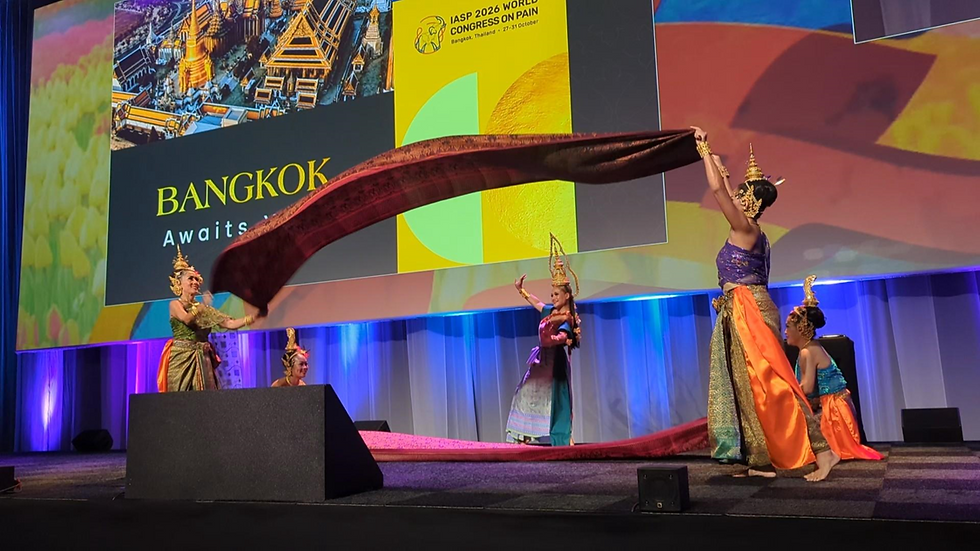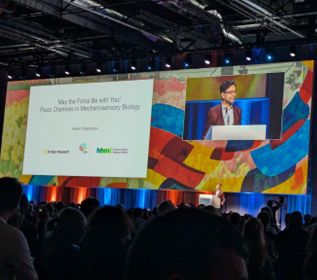The Fellowship's Legacy: 50 Years of Pain Research at IASP's World Congress
- Vandana Vedartham

- Mar 5
- 5 min read
Ever wondered what it's like to attend the International Association for the Study of Pain's World Congress? Here, Vandana Shree Vedartham Srinivasan summarises her experience at the 2024 conference, celebrating 50 years of IASP! With exciting sessions, wisdom from Nobel Laureates and early career networking sessions, the World Congress 2026 in Thailand sounds like one not to be missed!
The International Association for the Study of Pain (IASP) has been a guiding light in the field of pain research, education and clinical practice for many years. For decades, IASP has united thousands of members worldwide. One of the major highlights of 2024 is their World Congress, which marked a milestone anniversary for the organisation, celebrating its enduring commitment to collaboration, scientific progress and enhancing patient care on a global scale.
Chronic Pain and Epigenetics: My path in research
I am a final year PhD candidate, jointly affiliated with the University of Strasbourg, France and the University of Laval, Canada, and my research focusses on investigating the sex differences in chronic pain-induced mood, disorders with a particular emphasis on the epigenetic changes occurring in the Anterior Cingulate Cortex.
The Cingulate Cortex is a part of the limbic system that lies above the corpus callosum and is divided into the Anterior and the Posterior Cingulate Cortices. The Anterior Cingulate Cortex plays a crucial role in pain processing and emotional regulation.

Attending the congress provided a unique opportunity to enhance my understanding of chronic pain mechanisms, explore current research findings and connect with leading experts in the field.
A Deep Dive into Epigenetics and Omics in Pain
My week at the IASP World Congress 2024 kicked off with a fascinating Masterclass on Epigenetics and Omics in Pain, chaired by Dr. Rocco Giordiano. The session provided a comprehensive overview of the rapidly evolving field of pain research.
Dr. Arndt Nielsen opened the series with a thorough exploration of how the field has transitioned from monodisciplinary studies to more integrated, multidisciplinary research. He discussed the dynamic changes that occur in pain mechanisms and the critical role that epigenetics plays in shaping pain responses.
Following Dr. Nielsen, Dr. Giordiano delved deeper into the epigenetic changes associated with human pain and explored their underlying causes. Dr. Sandrine Geranton added to the discussion by highlighting how the 3D structure of DNA allows for methylation at distant sites to influence gene expression. Her talk also touched on the links between epigenetics and psychiatric disorders, broadening the scope of the discussion.
Dr. Bijar Ghafouri wrapped up the session with an insightful overview of proteomics in pain research. She emphasised that various proteomics techniques should be seen as complementary, not comparable, adding that these approaches collectively enhance our understanding of chronic pain.
The key takeaway from the masterclass was clear: epigenetics and omics are pivotal in advancing our knowledge of pain mechanisms and opening doors to more targeted interventions.
Central Sensitisation: Foe or Phantom?
Among the many highlights of the congress, one of the most thought-provoking sessions was the topical workshop titled “Central Sensitisation: Popular Phrase or Useful Concept? A Critical Discussion.” Dr. Emanuel van den Broeke, Dr. Kirsty Bannister, and Dr. Per Hansson led a dynamic discussion that explored the origins of the term "central sensitisation," its clinical implications, and what the future holds for this controversial concept.
The panellists debated whether central sensitisation is a useful clinical tool or merely a ‘buzzword’, providing diverse perspectives rooted in both history and cutting-edge research. The key take-home message being the reconsideration of the definition of what central sensitisation is and a proposal for greater clarity and consensus on what we define as Central Sensitisation.
By the end of the discussion, which thoroughly examined the literature, it was clear that central sensitisation, whether foe or phantom, awaits their verdict (as all of Middle-earth watches and wonders!).

Poster Sessions, Networking, and Early Career Support
The congress was also a hub of activity beyond the main sessions. The poster presentations were a particular highlight, offering an excellent mix of pre-clinical, clinical and theoretical research. This diverse range of topics provided a comprehensive overview of the latest advancements in pain research and allowed for the exchange of ideas across different scientific disciplines. The energy in the exhibition halls was palpable, with informative stalls offering valuable insights into the latest advancements in pain research and treatment. It was also wonderful to see the vibrant neuron stickers, from The Neuron Family, adorning many of the stalls throughout the exhibition, creating a shared sense of excitement among the attendees.

The Early Career Network (ECN) did a fantastic job organising various activities for early-stage researchers, including mentor-mentee sessions that emphasised the importance of work-life balance and mental health. These sessions were a timely reminder that success in research—and indeed in any field—requires not only dedication, but also self-care.

Wisdom from Nobel Laureates: Dr. David Julius and Dr. Ardem Patapoutian
A major spotlight of the congress were the plenary lectures, delivered by Nobel laureates Dr. David Julius and Dr. Ardem Patapoutian. Both were awarded the 2021 Nobel Prize in Physiology or Medicine for their ground-breaking discoveries of receptors for temperature and touch, which have been pivotal in advancing the understanding of pain mechanisms. Dr. Julius was recognised for his discovery of the TRPV1 receptor, which is activated by heat and plays a key role in pain perception. Dr. Patapoutian was honoured for his identification of the PIEZO channels, which are essential for sensing mechanical forces, like pressure. Their groundbreaking work has inspired countless scientists, and their presence at the congress was both motivating and humbling. Following their lectures, the ECN hosted an exclusive Q&A session where early career researchers had the rare opportunity to ask the laureates questions.
Both Dr. Julius and Dr. Patapoutian emphasised the importance of collaboration in advancing the field of pain research. They also spoke about the delicate balance between knowing when to push forward with a challenging project and when to step back and reassess. When asked about his philosophy of life, Dr. Julius’ answer was simple yet profound:
“Be happy, stay curious, and find your perfect match.” Dr David Julius
A Look Ahead: IASP 2026 in Bangkok
After a week filled with inspiring lectures, stimulating discussions, and invaluable networking opportunities, the congress concluded on a high note with three final plenary lectures. The excitement continued as the venue for the next IASP World Congress was announced—Bangkok, Thailand, in 2026.
As we look forward to the next gathering, it's clear that IASP's commitment to advancing pain research and improving patient outcomes remains as strong as ever. Here's to another 50 years of progress and innovation. See you in Bangkok!

This article was written by Vandana Shree Vedartham Srinivasan and edited by Rebecca Pope, with graphics produced by Lilly Green. If you enjoyed this article, be the first to be notified about new posts by signing up to become a WiNUK member (top right of this page)! Interested in writing for WiNUK yourself? Contact us through the blog page and the editors will be in touch.













Comments